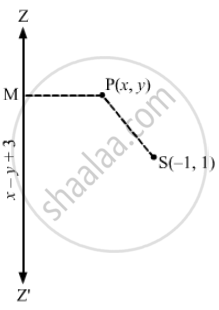Advertisements
Advertisements
Question
Find the equation of ellipse whose eccentricity is `2/3`, latus rectum is 5 and the centre is (0, 0).
Solution
Equations of ellipse is `x^2/a^2 + y^2/b^2` = 1 ......(i)
Given that, e = `2/3`
And latus rectum `(2b^2)/a` = 5
⇒ `b^2 = 5/2 a` .......(ii)
We know that b2 = a2 (1 – e2)
⇒ `(5a)/2 = a^2(1 - 4/9)`
⇒ `5/2 = a xx 5/9`
⇒ `a = 9/2`
⇒ `a^2 = 81/4`
And b2 = `5/2 xx 9/2 = 45/4`
Hence, the required equation of ellipse is `x^2(81/4) + y^2/(45/4)` = 1
⇒ `4/81 x^2 + 4/45 y^2` = 1
APPEARS IN
RELATED QUESTIONS
Find the equation for the ellipse that satisfies the given conditions:
Vertices (±6, 0), foci (±4, 0)
Find the equation for the ellipse that satisfies the given conditions:
Length of major axis 26, foci (±5, 0)
Find the equation for the ellipse that satisfies the given conditions:
b = 3, c = 4, centre at the origin; foci on the x axis.
Find the equation for the ellipse that satisfies the given conditions:
Centre at (0, 0), major axis on the y-axis and passes through the points (3, 2) and (1, 6)
Find the equation for the ellipse that satisfies the given conditions:
Major axis on the x-axis and passes through the points (4, 3) and (6, 2).
A man running a racecourse notes that the sum of the distances from the two flag posts form him is always 10 m and the distance between the flag posts is 8 m. find the equation of the posts traced by the man.
Find the equation of the ellipse in the case:
focus is (0, 1), directrix is x + y = 0 and e = \[\frac{1}{2}\] .
Find the equation of the ellipse in the case:
focus is (−1, 1), directrix is x − y + 3 = 0 and e = \[\frac{1}{2}\]
Find the equation of the ellipse in the case:
focus is (1, 2), directrix is 3x + 4y − 5 = 0 and e = \[\frac{1}{2}\]

Find the equation of the ellipse in the case:
eccentricity e = \[\frac{1}{2}\] and foci (± 2, 0)
Find the equation of the ellipse in the case:
eccentricity e = \[\frac{2}{3}\] and length of latus rectum = 5
Find the equation of the ellipse in the case:
eccentricity e = \[\frac{1}{2}\] and semi-major axis = 4
Find the equation of the ellipse in the case:
eccentricity e = \[\frac{1}{2}\] and major axis = 12
Find the equation of the ellipse in the case:
The ellipse passes through (1, 4) and (−6, 1).
Find the equation of the ellipse in the case:
Vertices (± 5, 0), foci (± 4, 0)
Find the equation of the ellipse in the following case:
Vertices (± 6, 0), foci (± 4, 0)
Find the equation of the ellipse in the following case:
Ends of major axis (0, ±\[\sqrt{5}\] ends of minor axis (± 1, 0)
Find the equation of the ellipse in the following case:
Length of major axis 26, foci (± 5, 0)
Find the equation of the ellipse in the following case:
Length of minor axis 16 foci (0, ± 6)
Find the equation of the ellipse in the following case:
Foci (± 3, 0), a = 4
A bar of given length moves with its extremities on two fixed straight lines at right angles. Any point of the bar describes an ellipse.
If P is a point on the ellipse `x^2/16 + y^2/25` = 1 whose foci are S and S′, then PS + PS′ = 8.
The line 2x + 3y = 12 touches the ellipse `x^2/9 + y^2/4` = 2 at the point (3, 2).
An ellipse is described by using an endless string which is passed over two pins. If the axes are 6 cm and 4 cm, the length of the string and distance between the pins are ______.
The equation of the ellipse having foci (0, 1), (0, –1) and minor axis of length 1 is ______.
